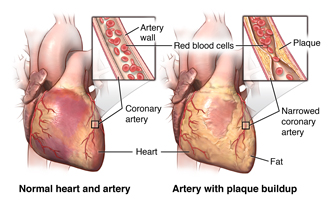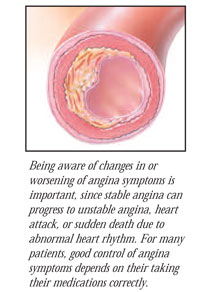Which of the Following Best Describes Angina Pectoris
It generally lasts 30 to 60 minutes. A 64-year-old man with long-standing angina pectoris and arterial hypertension dies of spontaneous intracerebral hemorrhage.

Angina Pectoris Johns Hopkins Medicine
Unstable Angina This condition is characterized by unexpected chest pain during rest.

. A spasm of the heart. Angina pectoris is the medical term for chest pain or discomfort due to coronary heart disease. This usually happens because one or more of the hearts arteries is narrowed or blocked also called ischemia.
Urinary incontinence may be experienced by patients during which of the following situations. Which of the following best describes ureteral pain. A It is brought on by exertion or stress B It is generally relieved by over-the-counter medications C It generally lasts 30 to 60 minutes D It results in death of a smaller portion of myocardium than does a heart attack.
It can be brought on by exertion or stress B. Mitral valve insufficiency b. Death of cardiac cells.
A spasm of the heart. It is generally relieved by over-the-counter medications C. He is unresponsive to painful stimuli.
The Psychiatric Technician knows that this symptom manifests itself as. It is a frequent symptom that results from the increased oxygen demands of the hypertrophied left ventricle the decreased time in diastole for myocardial perfusion and the decreased blood flow into the coronary arteries. It can be brought on by exertion or stress.
Bmyocardial infarction is usually caused by stress. It is a visceral pain that is typically dull aching. Which of the following best describes angina pectoris.
Cthe pain of angina pectoris usually goes away. This usually happens because one or more of the hearts arteries is. A 68-year-old obese woman BMI 32 kgm2 with a history of angina pectoris presents with substernal chest pain.
Angina pectoris is the medical term for chest pain or discomfort due to coronary heart disease. Angina pectoris is the medical term for chest pain or discomfort due to coronary heart disease. Which of the following best describes angina pectoris.
Cardiac arrest in children is more likely to be due to respiratory failure. Which of the following is the best position for a patient after he took the medication. A drop in the blood supply to the heart causing chest pain.
Which of the following statements regarding angina pectoris is true. It is generally relieved by over-the-counter medications. Bystanders state he complained of chest pain and then suddenly collapsed.
Variant Angina Also known as Prinzmetals variant angina or Angina inversa. Hardening of the arteries. At autopsy the heart appears globoid.
All of the above 10. P-I Which of the following best describes angina pectoris. 26 Which of the following statesments regarding angina pectoris is true.
Unlike stable angina unstable angina occurs unpredictably. 1Acute pain related to myocardial ischemia as evidenced by severe chest pain and tightness 2Ineffective tissue perfusion related to myocardial injury as evidenced by dyspnea decrease in Bp. Death of cardiac cells.
A client with angina pectoris ask the nurse What information does ECG provide. It results in death of a smaller portion of myocardium than does a heart attack. It is usually rare and typically occurs in.
Answer questions and review cases on these topics and more. Spasm of the heart. It occurs when the heart muscle doesnt get as much blood as it needs.
This usually happens because one or more of the hearts arteries is narrowed or blocked also called ischemia. Which of the following statements regarding angina pectoris is true. The nurse will administer nitroglycerine to a patient having angina pectoris.
Athe pain of myocardial infarction usually goes away on its own. It occurs when the heart muscle doesnt get as much blood as it needs. It results in death of a smaller portion of myocardium than does a heart attack D.
It also changes in frequency and may get worse over time. What percentage of patients with angina pectoris will have simultaneous dyspnea caused by transient increase in pulmonary venous pressures that accompany ventricular stiffening during an episode of myocardial ischemia. You are on scene with a 48-year-old unresponsive male patient.
It occurs when the heart muscle doesnt get as much blood as it needs. Which the following statements regarding angina pectoris is true. The patient experiences angina pectoris.
Which of the following bonds is weakest. It is generally relieved by over-the-counter medications. Death of the cardiac cells d.
It results in death of a smaller portion of myocardium than does a heart attack. Metaplasia 26 A 60-year-old man is rushed to the hospital with acute liver. It generally lasts 30 to 60 minutes.
The key difference between angina pectoris and a myocardial infarction is that. Results of laboratory studies and ECG confirm the diagnosis of myocardial infarction of the left ventricular wall. Hardening of the arteries c.
Coronary artery disease c. Vital signs are blood pressure 6842 pulse 36 and respiratory rate 3. During this phase the patient is encouraged to strengthen their muscles.
The following day she develops a mild fever of 38C 101F. Severe pectoral pain. Hardening of the arteries.
Tempory drop in the oxygen supply to the heart causin pain b. Stable Angina Also known as Angina Pectoris. A drop in the blood supply to the heart causing chest pain.
The following terms best describes the morphologic response to chronic injury in this patient. Below are sample questions you can expect to. The patient expires 24 hours after admission.
Which of the following best describes angina pectoris. Patients diagnosed with a stroke and is in Phase 2 of their rehabilitation. List the Nursing Diagnoses for Angina Pectoris.
Which of the following best describes the Babinski sign.
What Is Angina Learn The Symptoms Risk Factors Causes Treatment

Solved Which Of The Following Best Describes Angina Chegg Com

No comments for "Which of the Following Best Describes Angina Pectoris"
Post a Comment